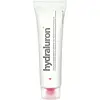What's inside
What's inside
 Key Ingredients
Key Ingredients

 Benefits
Benefits

 Concerns
Concerns

No concerns
 Ingredients Side-by-side
Ingredients Side-by-side

Water
Skin ConditioningGlycerin
HumectantHydrolyzed Yeast Extract
Skin ConditioningPentylene Glycol
Skin ConditioningTamarindus Indica Seed Gum
Emulsion StabilisingSodium Hyaluronate Crosspolymer
HumectantPalmitoyl Tripeptide-38
Skin ConditioningMyristoyl Nonapeptide-3
Skin ConditioningCopper Lysinate/Prolinate
Skin ConditioningMethylglucoside Phosphate
Skin ConditioningHydrolyzed Sodium Hyaluronate
Skin ConditioningSodium Hyaluronate
HumectantAhnfeltia Concinna Extract
Skin ConditioningSaccharide Isomerate
HumectantPolyglucuronic Acid
Skin ConditioningLactobacillus/Eriodictyon Californicum Ferment Extract
Skin ConditioningPseudoalteromonas Ferment Extract
HumectantPhospholipids
Skin ConditioningLecithin
EmollientHydroxypropyl Cyclodextrin
MaskingCetyl Hydroxyethylcellulose
Emulsion StabilisingPolyacrylate Crosspolymer-6
Emulsion StabilisingHexylene Glycol
EmulsifyingSalicylic Acid
MaskingCitric Acid
BufferingSodium Citrate
BufferingSodium Hydroxide
BufferingTrisodium Ethylenediamine Disuccinate
Ethoxydiglycol
HumectantLeuconostoc/Radish Root Ferment Filtrate
AntimicrobialSodium Benzoate
MaskingPotassium Sorbate
PreservativeEthylhexylglycerin
Skin ConditioningCaprylyl Glycol
EmollientPhenoxyethanol
PreservativeChlorphenesin
AntimicrobialWater, Glycerin, Hydrolyzed Yeast Extract, Pentylene Glycol, Tamarindus Indica Seed Gum, Sodium Hyaluronate Crosspolymer, Palmitoyl Tripeptide-38, Myristoyl Nonapeptide-3, Copper Lysinate/Prolinate, Methylglucoside Phosphate, Hydrolyzed Sodium Hyaluronate, Sodium Hyaluronate, Ahnfeltia Concinna Extract, Saccharide Isomerate, Polyglucuronic Acid, Lactobacillus/Eriodictyon Californicum Ferment Extract, Pseudoalteromonas Ferment Extract, Phospholipids, Lecithin, Hydroxypropyl Cyclodextrin, Cetyl Hydroxyethylcellulose, Polyacrylate Crosspolymer-6, Hexylene Glycol, Salicylic Acid, Citric Acid, Sodium Citrate, Sodium Hydroxide, Trisodium Ethylenediamine Disuccinate, Ethoxydiglycol, Leuconostoc/Radish Root Ferment Filtrate, Sodium Benzoate, Potassium Sorbate, Ethylhexylglycerin, Caprylyl Glycol, Phenoxyethanol, Chlorphenesin
 Reviews
Reviews

Ingredients Explained
These ingredients are found in both products.
Ingredients higher up in an ingredient list are typically present in a larger amount.
Ahnfeltia Concinna Extract helps soothe the skin and contains antioxidants. It is also used to improve the texture of products.
Ahnfeltia Concinna Extract is derived from a type of algae.
Chlorphenesin is a synthetic preservative. It helps protect a product against bacteria in order to extend shelf life. In most cases, Chlorphenesin is paired with other preservatives such as phenoxyethanol and caprylyl glycol.
Chlorphenesin is a biocide. This means it is able to help fight the microorganisms on our skin. It is also able to fight odor-releasing bacteria.
Chlorphenesin is soluble in both water and glycerin.
Studies show Chlorphenesin is easily absorbed by our skin. You should speak with a skincare professional if you have concerns about using Chlorphenesin.
Learn more about ChlorphenesinPhenoxyethanol is a preservative that has germicide, antimicrobial, and aromatic properties. Studies show that phenoxyethanol can prevent microbial growth. By itself, it has a scent that is similar to that of a rose.
It's often used in formulations along with Caprylyl Glycol to preserve the shelf life of products.
Sodium Benzoate is a preservative. It's used in both cosmetic and food products to inhibit the growth of mold and bacteria. It is typically produced synthetically.
Both the US FDA and EU Health Committee have approved the use of sodium benzoate. In the US, levels of 0.1% (of the total product) are allowed.
Sodium benzoate works as a preservative by inhibiting the growth of bacteria inside of cells. It prevents the cell from fermenting a type of sugar using an enzyme called phosphofructokinase.
It is the salt of benzoic acid. Foods containing sodium benzoate include soda, salad dressings, condiments, fruit juices, wines, and snack foods.
Studies for using ascorbic acid and sodium benzoate in cosmetics are lacking, especially in skincare routines with multiple steps.
We always recommend speaking with a professional, such as a dermatologist, if you have any concerns.
Learn more about Sodium BenzoateSodium Hyaluronate is hyaluronic acid's salt form. It is commonly derived from the sodium salt of hyaluronic acid.
Like hyaluronic acid, it is great at holding water and acts as a humectant. This makes it a great skin hydrating ingredient.
Sodium Hyaluronate is naturally occurring in our bodies and is mostly found in eye fluid and joints.
These are some other common types of Hyaluronic Acid:
Learn more about Sodium HyaluronateSodium Hydroxide is also known as lye or caustic soda. It is used to adjust the pH of products; many ingredients require a specific pH to be effective.
In small amounts, sodium hydroxide is considered safe to use. However, large amounts may cause chemical burns due to its high alkaline.
Your skin has a natural pH and acid mantle. This acid mantle helps prevent harmful bacteria from breaking through. The acid mantle also helps keep your skin hydrated.
"Alkaline" refers to a high pH level. A low pH level would be considered acidic.
Learn more about Sodium HydroxideWater. It's the most common cosmetic ingredient of all. You'll usually see it at the top of ingredient lists, meaning that it makes up the largest part of the product.
So why is it so popular? Water most often acts as a solvent - this means that it helps dissolve other ingredients into the formulation.
You'll also recognize water as that liquid we all need to stay alive. If you see this, drink a glass of water. Stay hydrated!
Learn more about Water